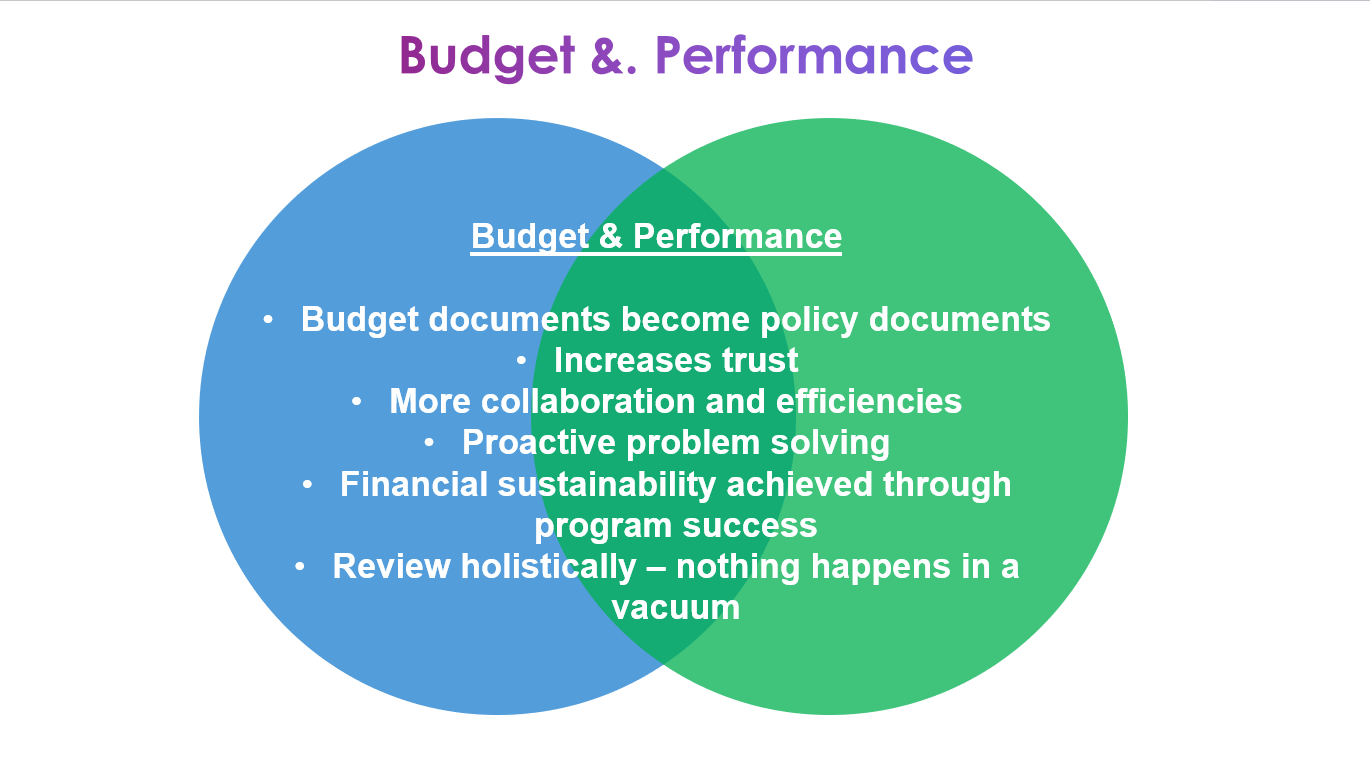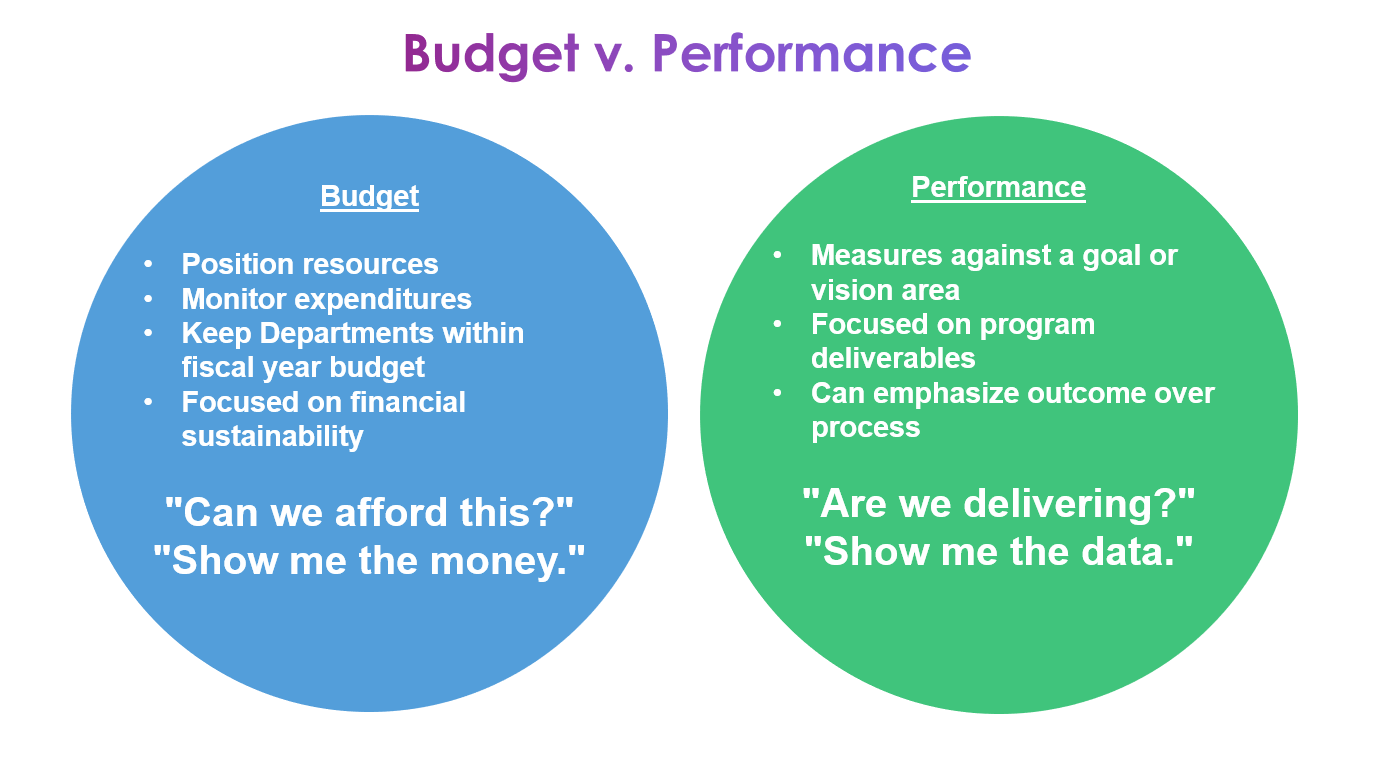
Today’s Morning Buzz is by Kayla Barber-Perrotta, Budget & Performance Manager at the City of Brighton, CO. Connect with Kayla on Linkedin and Instagram.
What I’m Reading: A Court of Silver Flames by Sarah J. Maas
What I’m Watching: Why Women Kill
What I’m Eating: A spicy hummus and roasted pepper sandwich-YUM!
Sometimes it pays to step back and view your daily work as an outsider. A few months ago, I had the honor of watching one of my employees, Kathryn Mortensen, present at a conference about our budget and performance processes, and it was an enlightening moment. I had become so focused on simply completing the day-to-day necessities, that I had simply forgotten to think about the why.
For me, moving the City of Brighton from a budget process to a budget and performance process is one of my top career achievements. At a minimum I’ve found a singular budget lens to be limiting to innovation and growth, and at worst I’ve found it lends itself to an us vs. them dynamic with departments that discourages honest information sharing. Viewing requests from a budget and performance lens, however, can be a catalyst for collaboration, proactive problem-solving, and organizational sustainability. It’s not a one-and-done budget process, it’s an ongoing relationship between the budget and performance team and the departments with a common goal of strengthening the organization.

The Budget and Performance Lens
What’s your pain point?
Anyone who knows my team will know this is our motto. It’s a simple question, but it fundamentally shifts the conversation. The usual budget process runs something like this: departments request a specific solution, the budget team asks a bunch of questions, they then rank it against all the other items asked for, the request is either funded or not, and that is the extent of the conversation. It is a simple yes or no—a transaction.
By shifting the conversation to start with the root cause or pain point as we call it at Brighton, we unleash possibilities. It is no longer a conversation about whether we add a position; it is a conversation about retention or training. Instead of band-aiding one capacity issue, we are focusing on addressing an ongoing organizational shortcoming.
So how does one do this? Stop only meeting departments once a year or only when there is a problem. Build regular and honest touchpoints into your process and invite departments to discuss their pain points often and early. We conduct bi-monthly meetings that provide regular opportunities for departments to discuss pain points as well as share financial and organizational initiatives with them. We also offer them a kit of tools for conducting deep analysis. They can send employees through our Performance & Leadership Academy, take advantage of a Spark! Facilitation event or utilize tools from our innovation station to conduct their own analysis.
How can we solve it?
Once you have a deep understanding of the pain point, it is time to solve it. To do this, we make sure we are pulling the right people into the room. Often, organizations will default to just having directors or managers in the room. This could be a factor of distrust, time management, or just “this is the way it’s always been done” thinking, but we have found time and again that having front-line employees in the room yields better solutions. They are the experts in their area, they experience their pain points more personally, and as such have a vested interest in solving them. They are the group for which the solution matters.
It is not uncommon for us to have various levels of a department in budget and performance discussions. Our budget reviews are timed so that departments can switch in and out their employees based on the focus of the discussions, we pre-share all questions so we can get real information rather than playing a “gotcha” game, and we are transparent in our financial information, so employees know the resources we are working with. We also give them tools to run their own analysis. The previously mentioned Spark! Events are often used in this phase as well with our team being brought in to act as a neutral facilitator as departments weigh their options. We have also created a Return on Investment (ROI) calculator to give front-line employees who are not as familiar with running that type of analysis the ability to review the sustainability of a proposal rather than just looking for the cheapest option today.
What does success look like?
Have you ever experienced scope creep? How about not having enough resources to fund priority programs yet you can’t seem to move on from programs that are failing to perform? These are regular symptoms of organizations and teams who simply don’t have a common understanding of what they are trying to achieve.
At Brighton, this analysis takes a few different forms. We adopted our first strategic plan only a few years ago to help the Council home in on what success looks like to them and have refined it ever since. This gives us overarching vision areas and goals to aim programs and prioritize resources. We further layered on performance metrics both tied to the strategic plan and tied to key programs and projects to help employees better understand desired outcomes and determine whether their work is achieving those outcomes or if they need to pivot and try something different. More recently, we have begun working with departments to define their own strategic and work plans to layer with the City’s overall plan. Together, these items create roadmaps for success and a common understanding of what we are trying to achieve.
Additionally, we work hard to tell our data story. It’s one thing for staff to know how the program they are working in is performing, but that success or failure may need to be communicated to their supervisors, our City Manager, our Council, and the public. As such, we have worked hard to create a culture where failure and rework of a program are simply business as usual. Furthermore, we’ve worked with employees to teach them how to tell that story.
When a program isn’t performing, we encourage departments to look back at the pain point. Why was the program started in the first place? How was success defined and what are your indicators that the chosen solution isn’t performing as anticipated? Are there other solutions you can pivot to? This is why we call this the budget and performance lens instead of the budget and performance checklist or even the budget and performance cycle. It isn’t a linear process. Employees and our team may need to live in any one of the spaces at any given time or in all of them at once.

